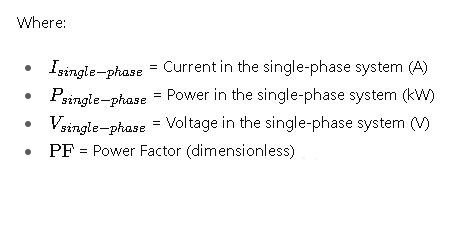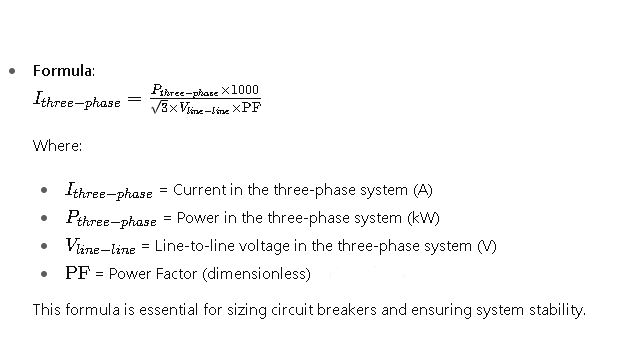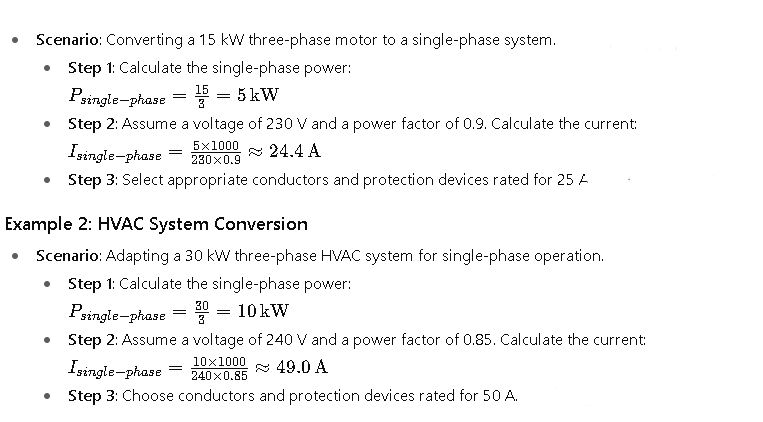Three-phase to single-phase power conversion enables industrial three-phase systems to operate safely on residential single-phase supplies.
This process involves transformers or phase converters, ensuring efficiency, load balance, and reliable electrical equipment performance.
Bidirectional Power Converter
Standard Conversion Formulas
1. Three-Phase to Single-Phase Power Conversion
- Formula:
- Where:
![]() = Power in the single-phase system (kW)
= Power in the single-phase system (kW)
![]() = Power in the three-phase system (kW)
= Power in the three-phase system (kW)
This formula assumes a balanced load and ideal conditions.
2. Current Calculation for Single-Phase System
- Formula:

3. Current Calculation for Three-Phase System

Practical Conversion Examples
Example 1: Industrial Motor Conversion

Conversion Methods
1. Phase Converters
- Rotary Phase Converters: Utilize a rotating machine to generate a third phase, providing a balanced three-phase output from a single-phase input.
- Static Phase Converters: Use capacitors to create a third phase, suitable for light loads but less effective for heavy-duty applications.
2. Transformer-Based Conversion
- Scott-T Transformer: Employs two transformers to derive two-phase power, which can then be used to approximate three-phase power.
- Le-Blanc Transformer: Utilizes a specially designed transformer to provide a balanced three-phase output from a single-phase input.
Voltage and Current Tables
| Voltage (V) | Line-to-Line Voltage (V) | Line-to-Neutral Voltage (V) | Conversion Factor | Power Factor (PF) |
|---|---|---|---|---|
| 120 | 208 | 120 | 1.732 | 0.8 |
| 230 | 400 | 230 | 1.732 | 0.85 |
| 240 | 415 | 240 | 1.732 | 0.9 |
These values are based on standard voltage levels used in various regions and industries.
Power Factor Considerations
- Definition: Power Factor (PF) is the ratio of real power (kW) to apparent power (kVA), indicating the efficiency of the electrical system.
- Calculation:

- Typical Values:
- Residential Loads: 0.8 – 0.9
- Industrial Loads: 0.85 – 0.95
A low power factor indicates poor efficiency and may require correction using capacitors or synchronous condensers.
Real-World Applications
Case Study 1: Agricultural Facility
- Challenge: An agricultural facility with three-phase equipment needed to operate on a single-phase supply.
- Solution: Installed a rotary phase converter to generate a balanced three-phase output from the available single-phase input.
- Outcome: The facility successfully operated its equipment without significant performance degradation.
Case Study 2: Commercial Building Retrofit
- Challenge: A commercial building undergoing retrofit required adapting existing three-phase HVAC systems to single-phase operation.
- Solution: Utilized a Scott-T transformer to provide the necessary three-phase power from the single-phase supply.
- Outcome: The building achieved efficient HVAC operation with minimal electrical infrastructure changes.
Optimization Strategies
- Load Balancing: Ensure that the load is evenly distributed across all phases to prevent overloading and potential equipment damage.
- Power Factor Correction: Implement power factor correction devices to improve efficiency and reduce energy costs.
- Regular Maintenance: Perform routine inspections and maintenance on phase converters and transformers to ensure reliable operation.
FAQs
Q1: What is three-phase to single-phase conversion?
A: It is the process of adapting three-phase electrical power to work with single-phase equipment or systems.
Q2: Why is this conversion necessary?
A: Many residential or small commercial devices only operate on single-phase power, while industrial supplies are often three-phase.
Q3: What are the common methods for conversion?
A: Rotary phase converters, static phase converters, and transformer-based solutions like Scott-T transformers.
Q4: Can all three-phase equipment run on single-phase power?
A: Not directly; some devices require a phase converter or transformer to operate safely.
Q5: What are the risks of improper conversion?
A: Overloading, overheating, reduced efficiency, or permanent equipment damage.
Q6: Does conversion affect power efficiency?
A: Yes, depending on the method and load balance, efficiency can decrease slightly.
Q7: Is phase balancing important in conversion?
A: Absolutely; unbalanced loads can cause voltage drops and equipment stress.
Q8: Are there real-world applications for this conversion?
A: Yes, including industrial machinery in homes, retrofitted commercial buildings, and agricultural facilities.
Q9: How can power factor affect conversion?
A: A low power factor reduces efficiency and may require correction devices to optimize performance.
Q10: Can I convert large motors for home use?
A: Yes, using appropriate converters, but careful calculation and professional guidance are recommended.

